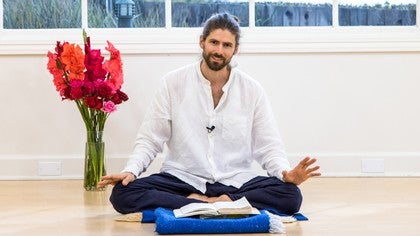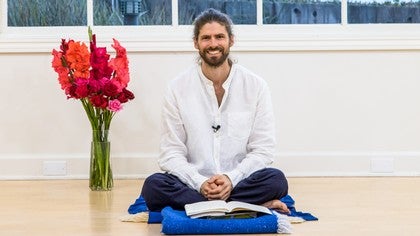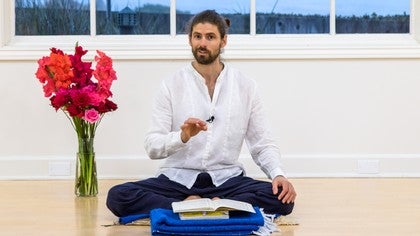Description
About This Video
Transcript
Read Full Transcript
So, in the 30th Sutra, Patanjali has mentioned that when we're practicing these obstacles can arise. In the 29th, he told us, however, that when we basically come into a state of deeper cohesion, they are absent. So basically, there's the idea that when these obstacles are manifesting, then we know we're not in yoga, but when we're truly in a sense of deep integration, they will not be present. So what are the signs that the obstacles are in operation? This is what Patanjali delineates here in the 31st Sutra.
So the idea is that the obstacles, they don't just show up all by themselves. They always have accompaniments. They always have companions with them, we might say. So what are they? Dukha, daurama nasyangame jatva, shvaa sa prasvaa sa vikse pa sahabhuvaa.
So sahabhuvaa, their companions, their attendants, their bedfellows, these obstacles, they don't arise all by themselves. If you are feeling vyaristhyana, sanjya, pramara, alasya, avirati, darshna, abranthi, darshna abhumi katva, anavasthi katva, if you're feeling any of those obstacles, then if they are manifest, what will we also experience? Dukha. What is dukha? Dukha literally means bad space.
We will feel some difficulty. We will feel some pain, some suffering. Or we may feel daurama nasyangame. So daurama nasyat, it's got the same, this dukh prefix in Sanskrit means difficult, bad, troubling, hard. Daurama nasyamanas is the mind, you might say.
So daurama nasyabhikse means dejection. You feel down. You feel dejected. Angame jatva, there is trembling and unsteadiness in the limbs or the members or the organs of your being. And the breath will be impacted.
The quality and duration of the breath in and the breath out will also be disturbed. And so, we can very readily know if we're in samadhi or not by whether these things are evident. So if we feel troubled and in difficult space, if we feel unsteady or our breath is disturbed, then we know we're not in a state of samadhi. And they say that when you're in a state of deep samadhi, the breath actually suspends. And this has been monitored as well.
People go into states of deep meditative awareness and the breath becomes very, very subtle. And so if you have it like on a monitor, on a screen, the breath pattern, it will be almost as if the breath person isn't breathing because the breath becomes so subtle. Or you watch somebody taking very deep easy, let's say yogic breaths in the day to day. You can barely tell they're breathing. Sometimes you see somebody who is troubled and the breath is very palpable in the chest.
The yogic is breathing in the belly, but the breath is moving in and out so subtly and slowly that you don't notice the movement from the big swollen baby belly to being drawn in because it moves so gently, so subtly. But when the breath is agitated at all, then we know one of these obstacles is in operation. And this is one of the benefits of being alert to one's breathing patterns because when we're aware of the breath, we can get a kind of advanced notice that something might be about to flare up at the physical level. Or we can notice, oh, this is actually affecting me emotionally more than I'm caring to admit right now. Maybe I need to just pause and acknowledge that so I can do something constructive about it.
So when these sorrows of the obstacles rise up, they don't rise up all alone. They have their companions. Now, is this bad news? I would suggest that actually it's not. There is encouragement to be had in this sutra because let's say, for example, that you are feeling dejected.
Your mental apparatus is running in the dejected groove. If you are feeling dejected, depressed, down, then if that mental groove of being dejected, depressed, down, if you're already rolling in it and turning in it, it's very hard by mental will alone to shift gear because you're already in that groove. But what has been very clear in these two sutras? What are the signs? They can affect your breath, they can affect your body, they can affect your mind, they can affect your emotions.
Similarly, the obstacles, they can affect your body, your mind, your emotions. And so it reminds us that yoga practice means to tend all the parts. And so this is very helpful because let's say you are in a dejected state. If you then do something physical, for example, you can shift yourself into a different groove by moving the body in space or you do something in which your senses have to do something different. Then it's like you invite your whole being to skip out of the dejected groove and come into another groove.
And so because we are constitutes of all these different powers and because the obstacles may manifest through combinations of them, but usually with one or two more dominant than others, we always have different approaches to come back to harmony. So I think this can be a useful thing to be aware of. It's like we can use the whole range of the possibilities that we have to help foster harmony. And when we practice yoga, sometimes people say, oh, I like doing physical yoga practices. Well, I say there is no such thing as a physical yoga practice.
There is no such thing as an intellectual practice. There is no such thing as a heart-centered emotional practice. If it's yoga, then it's inviting every part of you, your body, your mind and your emotions into the present moment. We can start from the initial platform of support or lens of inquiry, being the body, being the mind, being the intellect, being the emotions. But if it's a yoga practice, that will then invite the whole being into the activity.
So if you do a physical practice, you also recruit your mental acuity. You also invite all the sense powers to be fully participative in that practice. You bring an emotional intent and quality to the practice, and then it becomes yoga. Similarly, if you are doing an intellectual inquiry, then you have to situate that inquiry, not in the abstract realm of speculation, but in the real embodied realm of your own experience. And similarly, if you're going to do a heart-based practice, you have to embody it.
And you have to use your powers of awareness to actualize it. So it's not that we have, oh, I like physical yoga, I like mental yoga, I like emotional yoga. No. If we're doing yoga, we're inviting all of those powers to come together. But we can always start from different jumping off points.
You can always enter the ocean of practice from a different diving board. Terrible analogy, but I think it gives the idea.
Yoga Sutras of Patanjali: Obstacles and Opportunities
Comments

You need to be a subscriber to post a comment.
Please Log In or Create an Account to start your free trial.








